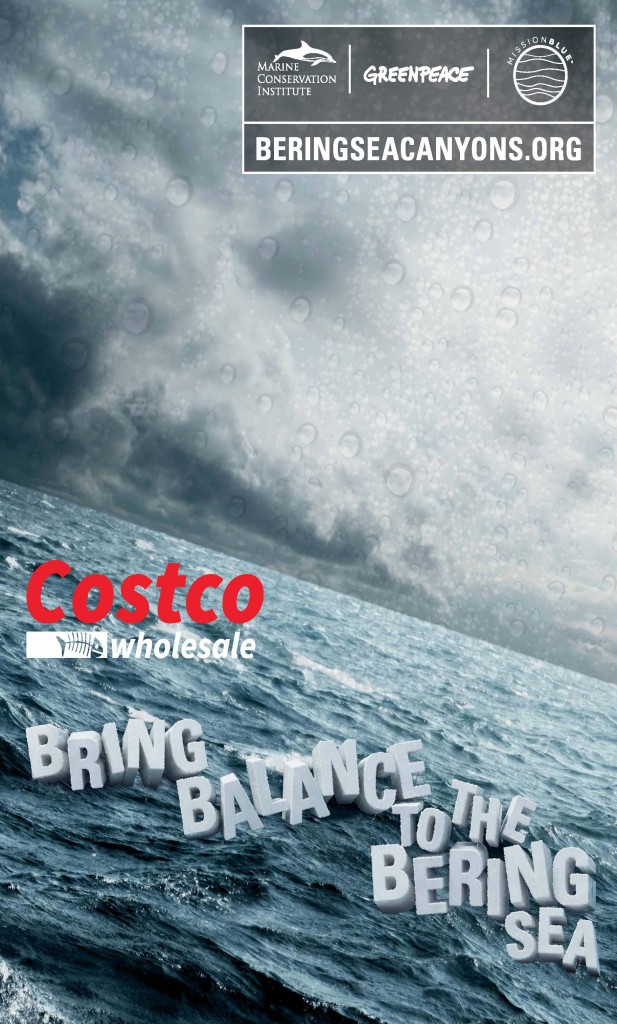Bring Balance to the Bering Sea
January 22, 2015
By Jackie Dragon (Originally published January 16, 2015 on Greenpeaceblogs.org)
This week in Seattle billboards and posters are popping up with a message for companies that profit from the sale of our ocean wildlife. Greenpeace, Mission Blue, and Marine Conservation Institute — three organizations committed to protecting important ocean places — have joined up to tell supermarkets that we need their help to protect special ocean places, like America’s Grand Canyons in the Sea.
An American gem is hidden from sight beneath the chilly waters of Alaska in the Bering Sea. Zhemchug and Pribilof canyons — designated a Hope Spot by “Her Deepness,” Dr. Sylvia Earle in 2013 — are the world’s largest underwater canyons, both more massive than the Grand Canyon. Unlike their protected terrestrial counterpart, the Bering Sea canyons support a vast array of marine life in one of our nation’s most valuable marine ecosystems, and they are threatened by our nation’s largest fishery.
Much of the seafood bought in the Northwest and across the country comes from the Bering Sea. We need companies like Costco, Target, and Albertsons – and your local grocery store — to stand up to protect our national treasure. We do not want to buy fish sticks or breaded fillets that may be destroying the fragile ecosystem in our undersea Grand Canyons.
Industrial fishing on the largest scale in history now scours the Bering Sea “fish basket,” scooping up well over two billion pounds of pollock alone – to make fish sticks and fast food fish sandwiches — each year. In the process many valuable species become their unfortunate bycatch — halibut, salmon, sharks, octopus, coral and more — and are wasted at sea. Coral and sponge habitat, hundreds of years in the making, are ripped from holds, crushed, and destroyed in seconds when factory fishing gear hits the bottom. Scientists do not know exactly what the long-term ecosystem effects will be of our systematic removal of billions of tons of sea life, along with the destruction of valuable seafloor habitat in the Bering Sea. We must protect some of this vital Green Belt, including the canyons, as an insurance policy for the future, especially in this era of heightened human impacts and climate change.
Together with many conservation groups, Alaskan indigenous groups — and even some of our nation’s largest supermarkets via letters of support — we have been urging protection for this rare and important ocean place for over a dozen years. Yet, decision makers with the authority to protect these majestic underwater canyons continue to resist taking action to curb fishing, despite hearing from more than 200,000 individuals and dozens of groups representing millions more. In fact, the ecologically sensitive Green Belt is the only major habitat in the Bering Sea with zero protections, completely open to fishing, and the devastating impacts of industrial fishing gear.
For this reason we’ve launched an ad campaign, calling on supermarkets, businesses that profit from the sale of marine wildlife, our shared public resource, to help us bring balance to the Bering Sea. While the canyons themselves are massive, they make up only a small fraction of the overall fishing area in the Bering Sea, so we know they can be protected without affecting the availability of fish on grocery store shelves.
This is the kind of unique place that should be preserved — as we have with Yellowstone and Yosemite on land. But, the political will needed to protect America’s underwater Grand Canyons, and other critical ocean places, won’t be created until companies that profit on our ocean resources stand together with the public to demand some balance.
Our oceans are in trouble, and facing mass extinctions of marine life, but we still have a chance to regain a healthy balance according to a major scientific study published in the Journal of Science this week. Scientists continue to urge us to create marine reserves, saying “limiting the industrialization of the oceans to some regions could allow threatened species to recover in other ones.”
To begin 2015 Greenpeace, Mission Blue and Marine Conservation Institute are launching a 2020 vision to unite people and companies in a shared vision — we can protect 20 percent of US ocean waters by 2020. By calling on forward thinking seafood businesses — companies that sell and profit from our ocean — to see clearly and develop 2020 vision for healthy, sustainable oceans, we believe we will also inspire the political will needed to bring true balance to the sea.









Our oceans are sick, and dying. They need our help now more than ever. without oceans there is nothing left. We depend on them for our survival. Please be on the RIGHT SIDE OF
A FUNDAMENTAL ISSUE.HELP OUR OCEANS ….DON’T HURT THEM ANYMORE.
PLEASE HELP
Who would ever imagined that sharks would be a threatened species-for soup! And only the fins are used. Then these sea felons dump the living, finless sharks back into the deep like chum. Bluefin tuna should be on the Endangered List. We will suffer for short-term wealth by depleting our fisheries.
Please save our great seas !!!!
Save the sea NOW!!
Without our healthy seas, nothing else counts. Please reconsider lucrative practices. Thank you
save our seas before it’s too late.